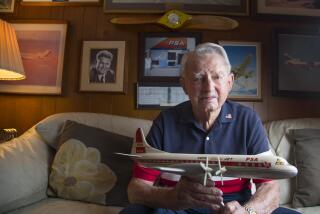From Single Plane, PSA Expanded to State’s Top Airline
- Share via
SAN DIEGO — Pacific Southwest Airlines, which agreed Monday to be acquired by USAir for about $400 million, began passenger service in 1949 with a leased, 31-seat DC-3 that flew once a week from San Diego to Oakland with a stop at Hollywood/Burbank airport. The San Diego-based airline eventually added several more leased DC-3s and, in 1955, purchased its first plane--a 70-passenger DC-4.
Even in the beginning, the airline that has asked passengers in recent years to “catch our smile,” used low fares to build passenger traffic. In 1951, for example, $17.25 bought a ticket on a PSA flight from San Diego to San Francisco.
PSA, which became a public company in 1963, entered the jet age in 1965, with the acquisition of five Boeing 727-100s. PSA used those jets to build its reputation as the low-cost, high-frequency carrier in what was becoming an increasingly competitive--and lucrative--”California corridor” between Los Angeles and San Francisco.
During the 1960s, PSA’s low fares included:
- Los Angeles to San Jose, $13.50.
- Ontario to San Francisco, $16.19.
- San Diego to Burbank, $7.14.
- Los Angeles to Oakland, $14.52
In 1971, PSA’s 27-jet fleet carried 5.6 million passengers, and industry analysts were describing it as a strong regional player that seemed poised for growth.
The airline grabbed--and held onto--nearly half of the traffic between Los Angeles and San Francisco.
However, when the price of jet fuel skyrocketed later in the decade, PSA found itself with a fuel-guzzling fleet that boosted operating costs and wrecked profit margins.
In 1974, for example, PSA took delivery of a pair of Lockheed L-1011 TriStars that by early 1975 were grounded because of high fuel costs. The planes sat on the ground for 11 years until a foreign buyer took them off PSA’s hands.
And, PSA’s success in the California corridor attracted increasing competition, including United Airlines and American Airlines.
Despite its role as a regional airline, PSA during the 1970s lobbied hard for federal deregulation of the airline industry. Interestingly, the more competitive market that deregulation produced set the stage for the wave of airline industry mergers that on Monday engulfed PSA.
Tragedy Struck Line
On Sept. 25, 1978, tragedy struck when a privately owned Cessna 172 collided with a PSA 727 over San Diego, killing 144 people--including 37 PSA employees. “We all knew someone on that flight,” a longtime employee said after the crash.
PSA also tried to expand beyond its role as a regional airline. In 1982, it signed an agreement to lease Braniff Airways aircraft and ground facilities after that Texas-based carrier went into bankruptcy proceedings. However, the deal fell apart when it failed to pass a court challenge.
PSA also has endured its share of strikes.
In 1973, it was hit by a Teamsters strike that reduced available flights by 40%; PSA felt the effects of that strike well into 1974.
In 1980, PSA flight crews struck for 52 days, halting scheduled service for the first time in the airline’s history.
In 1985, PSA employees traded wage reductions for stock in the airline. That trade could pay off now because USAir’s $17-per-share bid will boost the value of employee-owned stock by 450%--to $60 million.
Even in an era of increased competition, PSA has remained the airline of choice for many Californians and carries the largest share of passengers in the California airline market.
The airline still carries 48.7% of the 8 million passengers a year who are courted by PSA, AirCal, United and several smaller airlines with 450 daily flights between California destinations.
In August, for the first time, PSA carried more than 1 million passengers during a single month, and the airline could carry more than 11 million passengers during 1986.
But despite rising passenger traffic figures, PSA has found it difficult to register a profit. During the past year, the airline lost $649,000 on revenue of $635 million.
String of Losses
PSA has not been profitable since 1979 and has had $216.2 million in pretax losses during the past six years. However, it could report a profitable year during 1986, company officials stated recently.
“You can’t keep finishing the year with a pretax loss forever,” PSA President Russell Ray acknowledged earlier this month. “That’s not the way to do business.”
USAir’s Monday announcement ended months of speculation about which major airline would gobble up PSA.
However, as recently as late November, PSA Chairman Paul Barkley was telling reporters that he had “received no calls, no letters, no offers” for the airline. And he said during a recent speech in Los Angeles that “I don’t see why a strategically sound, midsize airline can’t be a successful player in this industry for years to come.”
Just days before American Airlines announced last month that it would acquire AirCal, Barkley was still arguing that his own airline lacked the “synergies” that would attract a suitor with “an offer we can’t refuse.”
But such an offer came late Sunday night, when USAir and PSA agreed to make PSA shareholders an offer that they are not likely to refuse.
“Our (airline) stock went public at $7 a share and we’re talking $17 a share,” Ray said on Monday. “That’s a fabulous return on investment.”
More to Read
Inside the business of entertainment
The Wide Shot brings you news, analysis and insights on everything from streaming wars to production — and what it all means for the future.
You may occasionally receive promotional content from the Los Angeles Times.








